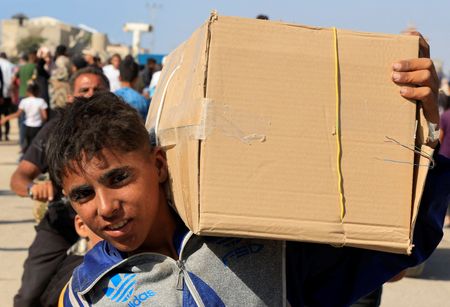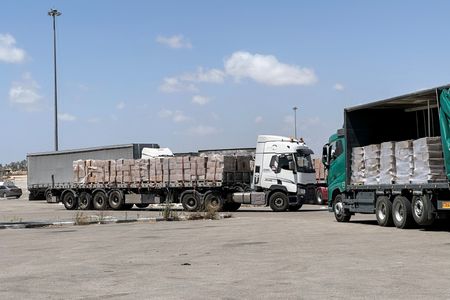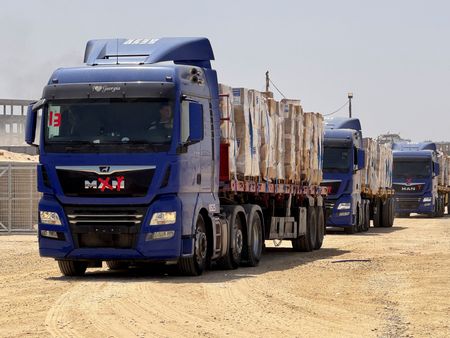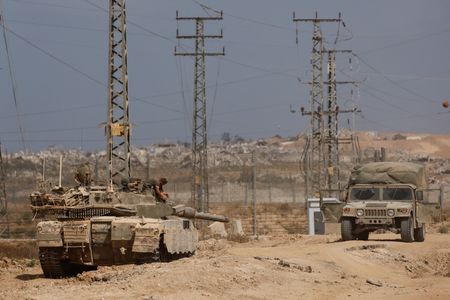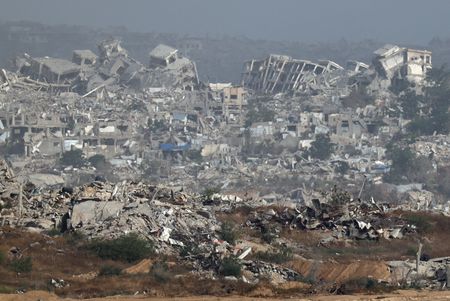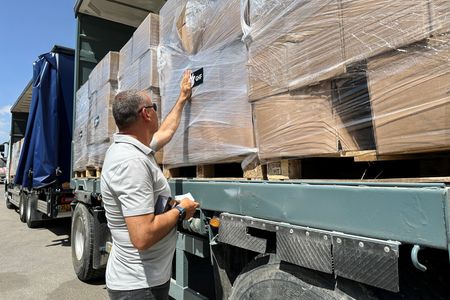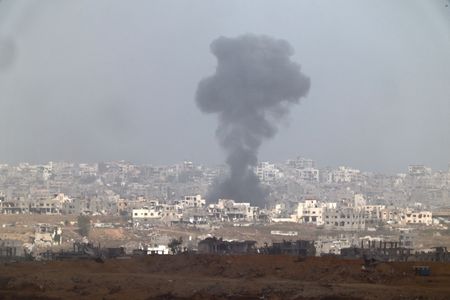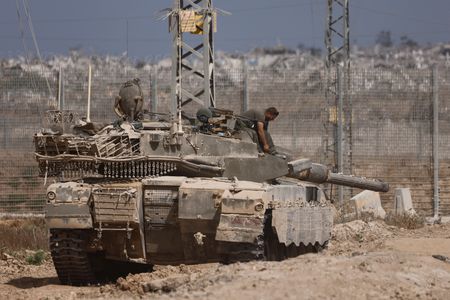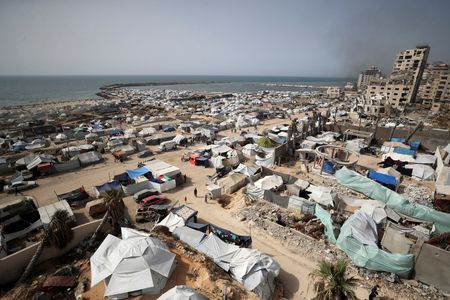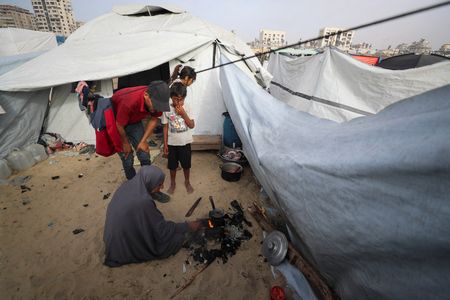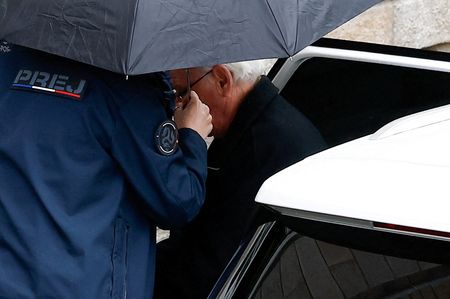By Nidal al-Mughrabi
CAIRO (Reuters) -Thousands of Palestinians on Tuesday rushed an aid distribution site in Gaza operated by a foundation backed by the United States and Israel, with desperation for food overcoming concern about biometric and other checks Israel said it would employ.
The Gaza Humanitarian Foundation said it had distributed about 8,000 food boxes, equivalent to 462,000 meals, after an 11-week Israeli blockade of the war-devastated enclave.
In the southern city of Rafah, which is under full Israeli army control, thousands of people including women and children, some on foot or in donkey carts, flocked towards the foundation’s distribution sites to receive food packages.
Videos, some of which Reuters could not immediately verify, showed lines of people walking through a wired-off corridor and into a large open field where aid was stacked. Later, images shared on social media showed large parts of the fence torn down as people jostled their way onto the site.
Israel and the GHF said, without providing evidence, that Hamas, Gaza’s dominant militant group, had tried to block civilians from reaching the aid distribution centre. Hamas denied the accusation.
Later on Tuesday, the Hamas media office accused the Israeli military of killing at least three Palestinians and wounding 46 others near one of the distribution sites, while seven people remained missing. A GHF spokesperson said the information from Hamas was “totally false.”
The foundation said at one point on Tuesday the number of people seeking aid was so great that its team had to pull back to allow people to “take aid safely and dissipate,” and to avoid casualties. It said there were no casualties, no one opened fire and normal operations later resumed.
There has been no immediate Israeli comment on the allegation by Hamas. Earlier, the Israeli military said its troops fired warning shots in the area outside the compound and that control was re-established.
A U.N. spokesperson called images of the incident “heartbreaking.”
SCREENING PROCEDURES
The foundation began aid deliveries on Monday, but Palestinians appeared to have heeded warnings, including from Hamas, about biometric screening procedures employed at the foundation’s aid distribution sites.
“As much as I want to go because I am hungry and my children are hungry, I am afraid,” said Abu Ahmed, 55, a father of seven. “I am so scared because they said the company belongs to Israel and is a mercenary, and also because the resistance (Hamas) said not to go,” he said in a message on the chat app WhatsApp.
Israel has said its forces will not be involved in distributing aid at the GHF sites.
But the endorsement of the plan by Israel and the U.S. has led many to question the neutrality of the foundation, including its own former chief, who resigned unexpectedly on Sunday.
The Israeli military said four GHF sites have been established. One of the sites is currently distributing aid, with a second site receiving stock, GHF said.
Israeli officials said one of the advantages of the new aid system is the opportunity to screen recipients to exclude anyone found to be connected with Hamas. Israel, at war with Hamas since October 2023, accuses Hamas of stealing supplies and using them to entrench its position. Hamas denies the accusations.
Humanitarian groups briefed on the foundation’s plans say anyone accessing aid will have to submit to facial recognition technology that many Palestinians fear will end up in Israeli hands to be used to track and potentially target them.
Details of how the system will operate have not been made public.
AID GROUPS BOYCOTT GHF
The United Nations and other international aid groups have boycotted the foundation, which they say undermines the principle that humanitarian aid should be distributed independently of the parties to a conflict, based on need.
“Humanitarian assistance must not be politicised or militarised,” said Christian Cardon, chief spokesperson of the International Committee of the Red Cross.
U.S. State Department spokesperson Tammy Bruce dismissed criticism of the aid program as “complaints about style,” telling reporters that assistance was being distributed despite Hamas’ efforts to disrupt the process.
In New York, U.N. spokesperson Stephane Dujarric told reporters the U.N. and its partners have a sound plan “to get aid to a desperate population” and that Israel was still allowing it to deliver some relief, but with a lot of obstacles.
The Israeli military said in a statement that 400 humanitarian aid trucks were waiting in Gaza for distribution but that the U.N. was still refusing to “do its job.”
In a statement late on Tuesday, U.S.-based World Central Kitchen said while Israel has allowed some of its trucks into the Kerem Shalom crossing with Gaza, the aid was being held at the border.
Last week, Israel eased its blockade, allowing a trickle of aid trucks from international agencies into Gaza.
But the amount of aid that has entered the densely populated coastal enclave has been a fraction of the 500-600 trucks that U.N. agencies estimate are needed every day.
“Before the war, my fridge used to be full of meat, chicken, dairy, soft drinks, everything, and now I am begging for a loaf of bread,” Abu Ahmed told Reuters via a chat app.
As a small aid flow has resumed, Israeli forces – now in control of large parts of Gaza – have kept up attacks on various targets around the enclave, killing 3,901 Palestinians since a two-month ceasefire collapsed in mid-March, according to the Gaza Health Ministry.
In all, more than 54,000 Palestinians have been killed in Israel’s air and ground war, Gaza health authorities say. It was launched following a cross-border Hamas-led attack on October 7, 2023, that killed some 1,200 people and saw 251 taken hostage into Gaza, according to Israeli tallies.
(Reporting by Nidal al-Mughrabi; writing by Nidal al-Mughrabi and Matt Spetalnick; additional reporting by Emma Farge in Geneva, Alex Cornwell and Emily Rose in Jerusalem, Michelle Nichols in New York; editing by Mark Heinrich, Sharon Singleton, Hugh Lawson, Cynthia Osterman and Rod Nickel)

